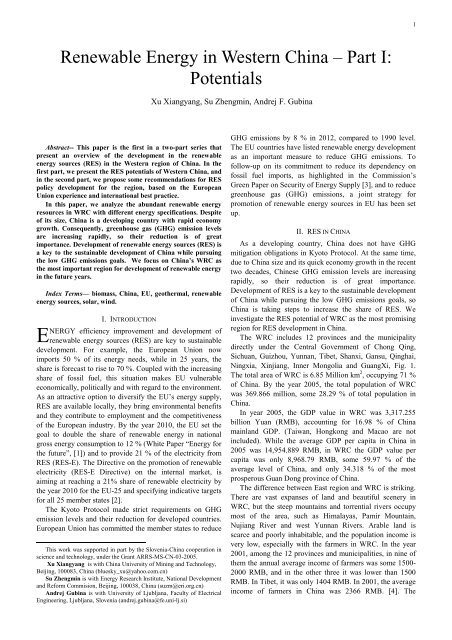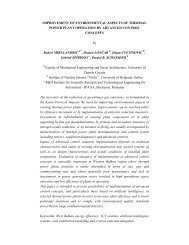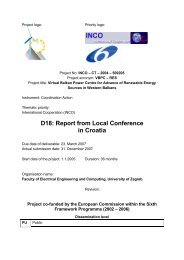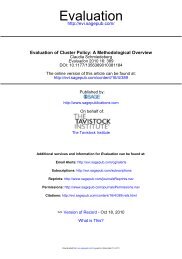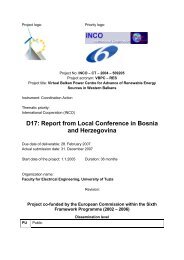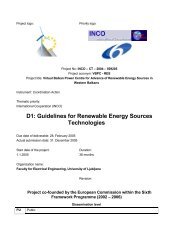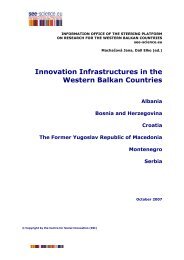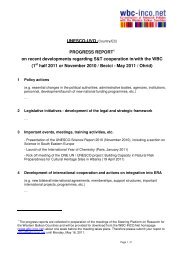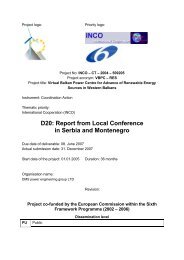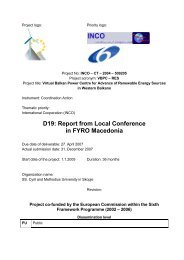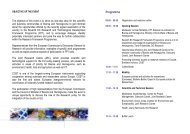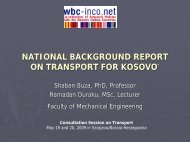Prva stran - WBC-INCO Net
Prva stran - WBC-INCO Net
Prva stran - WBC-INCO Net
You also want an ePaper? Increase the reach of your titles
YUMPU automatically turns print PDFs into web optimized ePapers that Google loves.
Renewable Energy in Western China – Part I:<br />
Potentials<br />
Abstract-- This paper is the first in a two-part series that<br />
present an overview of the development in the renewable<br />
energy sources (RES) in the Western region of China. In the<br />
first part, we present the RES potentials of Western China, and<br />
in the second part, we propose some recommendations for RES<br />
policy development for the region, based on the European<br />
Union experience and international best practice.<br />
In this paper, we analyze the abundant renewable energy<br />
resources in WRC with different energy specifications. Despite<br />
of its size, China is a developing country with rapid economy<br />
growth. Consequently, greenhouse gas (GHG) emission levels<br />
are increasing rapidly, so their reduction is of great<br />
importance. Development of renewable energy sources (RES) is<br />
a key to the sustainable development of China while pursuing<br />
the low GHG emissions goals. We focus on China’s WRC as<br />
the most important region for development of renewable energy<br />
in the future years.<br />
Index Terms— biomass, China, EU, geothermal, renewable<br />
energy sources, solar, wind.<br />
I. INTRODUCTION<br />
NERGY efficiency improvement and development of<br />
E<br />
renewable energy sources (RES) are key to sustainable<br />
development. For example, the European Union now<br />
imports 50 % of its energy needs, while in 25 years, the<br />
share is forecast to rise to 70 %. Coupled with the increasing<br />
share of fossil fuel, this situation makes EU vulnerable<br />
economically, politically and with regard to the environment.<br />
As an attractive option to diversify the EU’s energy supply,<br />
RES are available locally, they bring environmental benefits<br />
and they contribute to employment and the competitiveness<br />
of the European industry. By the year 2010, the EU set the<br />
goal to double the share of renewable energy in national<br />
gross energy consumption to 12 % (White Paper “Energy for<br />
the future”, [1]) and to provide 21 % of the electricity from<br />
RES (RES-E). The Directive on the promotion of renewable<br />
electricity (RES-E Directive) on the internal market, is<br />
aiming at reaching a 21% share of renewable electricity by<br />
the year 2010 for the EU-25 and specifying indicative targets<br />
for all 25 member states [2].<br />
The Kyoto Protocol made strict requirements on GHG<br />
emission levels and their reduction for developed countries.<br />
European Union has committed the member states to reduce<br />
This work was supported in part by the Slovenia-China cooperation in<br />
science and technology, under the Grant ARRS-MS-CN-03-2005.<br />
Xu Xiangyang is with China University of Mining and Technology,<br />
Beijing, 100083, China (bluesky_xu@yahoo.com.cn)<br />
Su Zhengmin is with Energy Research Institute, National Development<br />
and Reform Commision, Beijing, 100038, China (suzm@eri.org.cn)<br />
Andrej Gubina is with University of Ljubljana, Faculty of Electrical<br />
Engineering, Ljubljana, Slovenia (andrej.gubina@fe.uni-lj.si)<br />
Xu Xiangyang, Su Zhengmin, Andrej F. Gubina<br />
GHG emissions by 8 % in 2012, compared to 1990 level.<br />
The EU countries have listed renewable energy development<br />
as an important measure to reduce GHG emissions. To<br />
follow-up on its commitment to reduce its dependency on<br />
fossil fuel imports, as highlighted in the Commission’s<br />
Green Paper on Security of Energy Supply [3], and to reduce<br />
greenhouse gas (GHG) emissions, a joint strategy for<br />
promotion of renewable energy sources in EU has been set<br />
up.<br />
II. RES IN CHINA<br />
As a developing country, China does not have GHG<br />
mitigation obligations in Kyoto Protocol. At the same time,<br />
due to China size and its quick economy growth in the recent<br />
two decades, Chinese GHG emission levels are increasing<br />
rapidly, so their reduction is of great importance.<br />
Development of RES is a key to the sustainable development<br />
of China while pursuing the low GHG emissions goals, so<br />
China is taking steps to increase the share of RES. We<br />
investigate the RES potential of WRC as the most promising<br />
region for RES development in China.<br />
The WRC includes 12 provinces and the municipality<br />
directly under the Central Government of Chong Qing,<br />
Sichuan, Guizhou, Yunnan, Tibet, Shanxi, Gansu, Qinghai,<br />
Ningxia, Xinjiang, Inner Mongolia and GuangXi, Fig. 1.<br />
The total area of WRC is 6.85 Million km 2 , occupying 71 %<br />
of China. By the year 2005, the total population of WRC<br />
was 369.866 million, some 28.29 % of total population in<br />
China.<br />
In year 2005, the GDP value in WRC was 3,317.255<br />
billion Yuan (RMB), accounting for 16.98 % of China<br />
mainland GDP. (Taiwan, Hongkong and Macao are not<br />
included). While the average GDP per capita in China in<br />
2005 was 14,954.889 RMB, in WRC the GDP value per<br />
capita was only 8,968.79 RMB, some 59.97 % of the<br />
average level of China, and only 34.318 % of the most<br />
prosperous Guan Dong province of China.<br />
The difference between East region and WRC is striking.<br />
There are vast expanses of land and beautiful scenery in<br />
WRC, but the steep mountains and torrential rivers occupy<br />
most of the area, such as Himalayas, Pamir Mountain,<br />
Nujiang River and west Yunnan Rivers. Arable land is<br />
scarce and poorly inhabitable, and the population income is<br />
very low, especially with the farmers in WRC. In the year<br />
2001, among the 12 provinces and municipalities, in nine of<br />
them the annual average income of farmers was some 1500-<br />
2000 RMB, and in the other three it was lower than 1500<br />
RMB. In Tibet, it was only 1404 RMB. In 2001, the average<br />
income of farmers in China was 2366 RMB. [4]. The<br />
1


